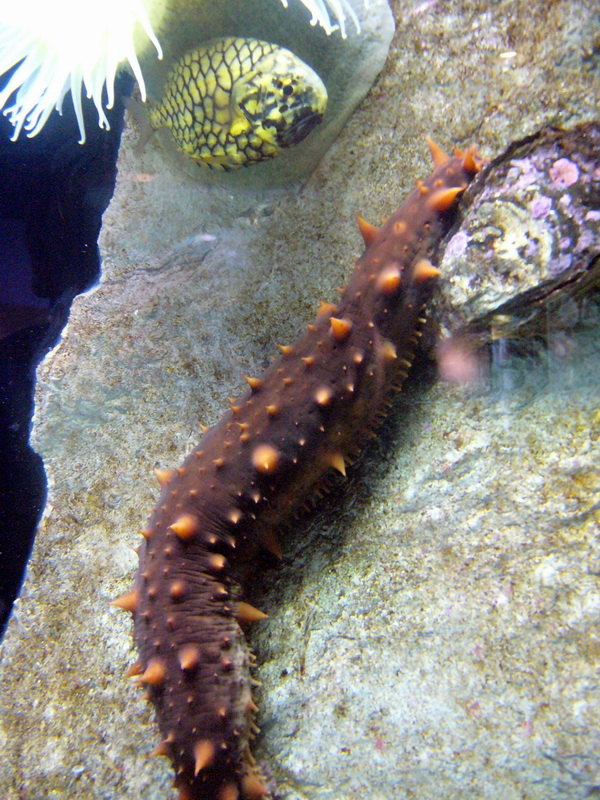Sea Cucumber (Class: Holothuroidea) - Wiki Sea cucumber
From Wikipedia, the free encyclopedia
[Photo] Holoturia (pepino de mar) en la Sala Humboldt del Aquarium Finisterrae (Casa de los Peces), en la Coru??a, Galicia, Espa??a. Holothuroidea (sea cucumber) in Sala Humboldt of Aquarium Finisterrae (House of the Fishes), in Corunna, Galicia, Spain. Date 13:52, 25 April 2007. Author Drow_male http://commons.wikimedia.org/wiki/User:Drow_male
The sea cucumber is an echinoderm of the class Holothuroidea, with an elongated body and leathery skin, which is found on the sea floor worldwide. It is so named because of its cucumber-like shape. Like all echinoderms, sea cucumbers have an endoskeleton just below the skin, but this can actually be absent in some species.
Overview
Sea cucumbers are generally scavengers, feeding on debris in the benthic layer. (There are only a few exceptions to this, most notably a few pelagic cucumbers and the species Rynkatropa pawsoni, which has a commensal relationship with deep-sea angler fish.) The diet of most cucumbers consists of plankton and decaying organic matter found in the sea. One way they might get a supply of food is to position themselves in a current where they can catch food that flow by with their tentacles when they open. Another way is to sift through the bottom sediments using their tentacles. They can be found in great numbers beneath fish farms.
Some species in the family Holothuriidae (coral-reef sea cucumbers) within the order Aspidochirotida can defend themselves by expelling sticky tubules that entangle potential predators. Cuvierian tubules are enlargements of the respiratory tree that float freely in the coelom. When startled, a sea cucumber that possesses these tubules can expel some of them through a tear in the wall of the cloaca; this process is called eversion. The sea cucumber does not expel all of the tubules at one time. Replacement tubules grow back in one-and-a-half to five weeks , depending on the species.
They can be found in great numbers on the deep sea floor, where they often make up the majority of the animal biomass. The body of deep water holothurians is made of a tough gelatinous tissue with unique properties that makes the animals able to control their own buoyancy, making it possible for them to both living on the ocean floor or floating over it to move to new locations with a minimum of energy.
Also in more shallow waters they can form dense populations. The strawberry sea cucumber (Squamocnus brevidentis) of New Zealand, lives on rocky walls around the southern coast of the South Island where the number are something reaching densities of 1,000 animals in a square metre. For this reason, one such area in Fiordland is simply called the strawberry fields.
Sea cucumbers extract oxygen from water in a pair of 'lungs' or respiratory 'trees' that branch off the cloaca just inside the anus, so that they 'breathe' by drawing water in through the anus and then expelling it. A variety of fishes, most commonly pearl fishes, have evolved a commensalistic symbiotic relationship (commensalism) with sea cucumbers in which the pearl fish will live in sea cucumber's cloaca using it for protection from predation, a source of food (the nutrients passing in and out of the anus from the water), and to develop into their adult stage of life. Many polychaete worms and crabs have also specialized to use the cloacal respiratory trees for protection by living inside the sea cucumber.
Sea cucumbers reproduce by releasing sperm and ova into the ocean water. Depending on conditions, one organism can produce thousands of gametes.
The largest American species is Holothuria floridana, which abounds just below low-water mark on the Florida reefs.
The most common way to separate the sublasses is by looking at their oral tentacles. Subclass Dendrochirotacea has 8-30 oral tentacles, subclass Aspidochirotacea has 10-30 leaflike or shieldlike oral tentacles, while subclass Apodacea may have up to 25 simple or pinnate oral tentacles and is also characterized by reduced or absent tube feet, as in the order Apodida.
http://en.wikipedia.org/wiki/Sea_cucumber
| The text in this page is based on the copyrighted Wikipedia article shown in above URL. It is used under the GNU Free Documentation License. You may redistribute it, verbatim or modified, providing that you comply with the terms of the GFDL. |
